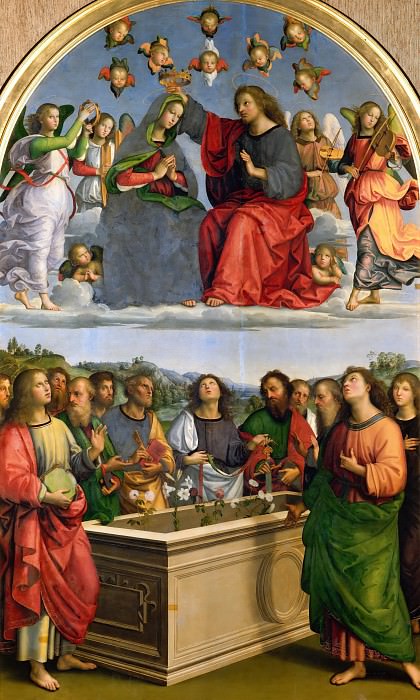Oddi altarpiece – Coronation of the Virgin Raphael (1483-1520)
Raphael – Oddi altarpiece - Coronation of the Virgin
Edit attribution
Download full size: 2515×4196 px (2,9 Mb)
Painter: Raphael
Location: Vatican Museums (Musei Vaticani), Vatican.
The work was painted in 1502-1503 for the altar of Oddi. An interesting fact in the creation of this painting was that the artist did not independently determine the main components of the image. At the same time his favorite religious themes in the early stages of creativity found its admirers. Speaking of the upper part of the canvas, there is a certain borrowing of the silhouettes from Perugino’s work The Ascension of Our Lady.
Description of Raphael Santi’s painting "Crowning of Mary
The work was painted in 1502-1503 for the altar of Oddi. An interesting fact in the creation of this painting was that the artist did not independently determine the main components of the image. At the same time his favorite religious themes in the early stages of creativity found its admirers.
Speaking of the upper part of the canvas, there is a certain borrowing of the silhouettes from Perugino’s work The Ascension of Our Lady. In doing so, Raphael favored a careful painting of the altar arrangement, as well as the faces and other important religious elements arranged in the work. In this way one can note the impressive superiority of the student over the teacher.
In this painting we can consider the creator’s familiarity with the beautiful exaltations of Rome and Florence. As we know, Raphael was an avid traveler, wishing to enrich his spiritual world and dissolve himself in the profound grandeur of his surroundings. Such a manner was reflected in his works.
Looking at the work, one can’t help but notice the minimalized distinction between the so-called participants of the canvas. In this way the artist wanted to emphasize the idea of the closeness of the Christian soul with the saints.
Traditionally, Mary is represented in a blue cloak covering her head. On the sides are angels and patrons. Contemporaries described their feelings after viewing the painting, speaking of the presence of a sense of lightness and "airiness," and the musical instruments on the upper tier of the canvas as if through the image gave a melody of calm. They are presented in the painting as a solemn element by which Mary is welcomed into heaven.
The lower tier of the painting is represented as waiting. Christians are watching the coronation process, putting aside their usual activities. Here one can speak of the unity of the people through Mary and her importance in religion.
Кому понравилось
Пожалуйста, подождите
На эту операцию может потребоваться несколько секунд.
Информация появится в новом окне,
если открытие новых окон не запрещено в настройках вашего браузера.
You need to login
Для работы с коллекциями – пожалуйста, войдите в аккаунт (open in new window).




















You cannot comment Why?
In the upper tier, Jesus, dressed in red, is crowning Mary, who is kneeling in blue and praying, with a golden crown. They are seated on clouds, surrounded by a heavenly court. Several cherubic figures are scattered amongst them, some holding crowns as if to assist in the ceremony. Two angels flank the central figures: one on the left, with green robes, holds a wreath, while the other on the right, in golden robes, plays a lute. The composition here is symmetrical and harmonious, conveying a sense of divine order and celebration.
The lower tier presents Marys Dormition (death) and assumption. A tomb, adorned with roses, contains a deceased figure representing Mary. A group of apostles, identifiable by their traditional halos and solemn expressions, are gathered around the tomb, some looking up towards the divine scene above with awe and sorrow. Their faces express a range of emotions, from grief to wonder. The landscape in the background features rolling hills and a mountainous horizon, grounding the earthly scene.
The subtexts of this artwork relate to core Christian beliefs. The upper scene celebrates the exaltation of Mary to Queen of Heaven, a significant honor bestowed upon her for her role as the mother of Christ. This highlights her importance in salvation history and her intercessory role for humanity. The lower scene depicts her passing from earthly life and her ascension into heaven, a concept that assures believers of an afterlife and the triumph of faith over death. The presence of the apostles signifies the witnesses to these significant events and the foundation of the Church. The roses often symbolize purity and the Virgin Mary, reinforcing her divine nature and her connection to a heavenly paradise. The overall composition, with the divine clearly overseeing the earthly, emphasizes the connection between the heavenly and earthly realms and the ultimate victory of Gods plan.